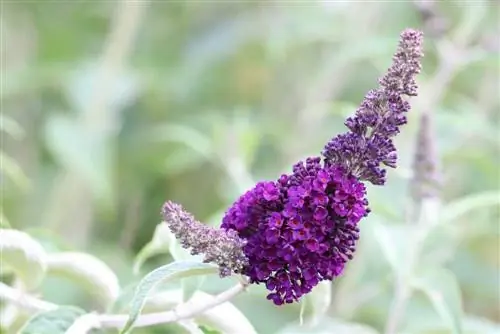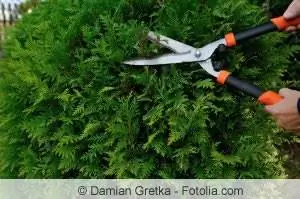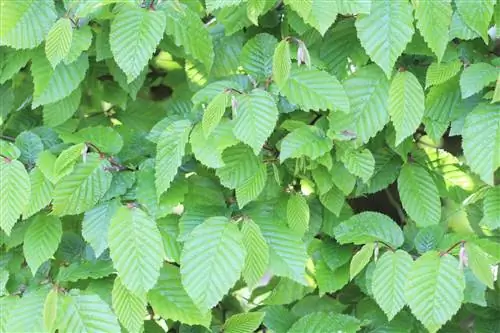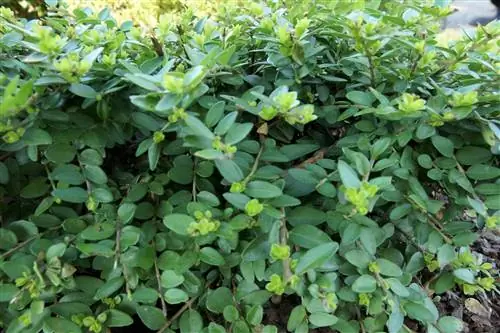- Author admin [email protected].
- Public 2023-12-17 03:39.
- Last modified 2025-01-24 12:45.
If you want wind and privacy protection for your garden all year round, you can choose a thuja hedge. The Thuja Brabant is one of the most popular plants for an optimal thuja hedge. It is undemanding, easy to care for, grows extremely quickly and densely and will soon provide the desired evergreen privacy screen. However, even with the undemanding thuja, a few points regarding location, planting and care should be taken into account so that the joy of a magnificent thuja hedge is guaranteed from the start.
Site conditions
The thuja hedge is intended to delineate the evergreen garden and is ideal for this purpose. However, the thuja needs sun or at least light shade in order to thrive optimally and greenly. If a thuja - whether planted alone or in a hedge - is too dark, it will soon look brown, holes will form and ultimately it will die.
Buy and plant a thuja hedge
As with all plants, it is worth taking a look at the roots of Thuja before buying. The root balls should be well developed. This is the best prerequisite for the plants to grow well. The planting holes should be twice as deep and twice as wide as the root ball.
The best time to plant a thuja hedge is late spring after the last frost or early summer. It can also be planted in early fall before the first frost. The plants then still have time to grow and prepare for winter.
The Thuja does not place any great demands on the soil. Even a simple garden soil that retains moisture is ideal. To ensure quick and strong rooting, horn shavings or a mixture of humus, peat or rotted compost can be added to the potting soil. This mixture optimally supplies the plants with the necessary nutrients and the roots develop quickly and powerfully. To give the plant support, the potting soil must be pressed firmly and watered well. In the following week, the plants are grateful for at least three more generous waterings. This also applies if it rains.
Planting spacing
Of course it is tempting to plant the plants very close together. This makes the hedge look dense. But it soon turns out to be a serious mistake. If the plants are too close together, they will quickly hinder each other. They don't get enough nutrients and can no longer develop well. The result is a poor hedge. It is optimal to maintain a distance of approximately 40 cm between individual plants. This may look patchy at the moment, but with proper care these will close very quickly.
Care measures
Caring for a thuja hedge is uncomplicated, but should still be done regularly. This includes watering the young plants, even in rainy weather. The older hedge should only be watered when it is very dry and hot. Covering the ground under the hedge with bark mulch reduces evaporation and saves you from having to water it frequently. The mulch also prevents weeds from growing into the hedge.
Fertilization
Annual fertilization in mid-summer strengthens the plants, ensures optimal growth and is ideal as preparation for winter. A commercially available hedge fertilizer is sufficient here. Water well after fertilization. Fertilization in autumn is not recommended. By giving nutrients too late, the hedge cannot adequately prepare for winter rest.
Cutting the thuja hedge
The thuja can be cut all year round except in times of frost. But there are two times when it is particularly good to carry out cutting measures. One time is in spring, before budding begins, the other is in late summer. The cut should always be carried out gently.
Tips for speed readers
- Only shorten young shoots by a few centimeters.
- Keep the hedge wide at the bottom and narrow at the top. This means that sunlight and water reach the lower areas optimally.
- The shortening should be done evenly. A taut thread is used for orientation.
If you cut a thuja hedge radically, ugly holes are created that are very difficult to close or, unfortunately, often not at all. That's why it's better to prune a little twice a year rather than a lot once.
Attention
The thuja hedge is not only a visual beauty, it is also a popular nesting place for many garden birds.
That's why the federal states specify the times at which larger cuts can be made. But even with small care cuts, the gardener should make sure that there is no occupied nest. Otherwise you should avoid a cut.
Protect interfaces
The thuja hedge is robust and resilient. However, if fresh interfaces are exposed to the sun unprotected, they will burn in a short time. That's why not only the time of year, but also the weather of the day is important for hedge trimming. An overcast day is optimal. If this is not possible, the fresh cuts should be immediately covered with a garden fleece. It provides the shade needed to close the interfaces and can remain on the hedge for a maximum of 2 days. After each cut, the hedge must be watered well. Foil is absolutely unsuitable as a cover, as heat and solar radiation are increased under it.
Winter protection
A thuja hedge is absolutely winter hardy and does not need any protection from frost and cold. Some Thuja species turn brownish in the cold season when the days become shorter. This is a natural form of adaptation to winter. In spring the plants turn green again. If you want to have an absolutely green hedge even in winter, the emerald cultivar is the right choice.
Tip:
In very dry winters, thujas should also be watered occasionally on frost-free days to prevent them from drying out.
Pests and diseases
The Thuja is a very robust plant. Provided it is properly cared for, diseases and pests cannot harm it. If the plants do become infected, attention should be paid to the location, watering behavior and the quality of the soil.
Poisonous or non-toxic?
All arborvitae are poisonous species because essential oils and thujone in their branch tips can cause skin inflammation. Children should not be allowed to eat any thuja. Ingestion of the poison leads to stomach and intestinal inflammation, kidney and liver damage and convulsions and, depending on the amount ingested, even death. Thuja is also poisonous to almost all animals in the house, garden and pasture. Horses are the most sensitive, while donkeys appear to be resistant. Poisoning in horses is manifested by stomach and intestinal problems, cramps, and changes in the liver and kidneys.
What you should know about thuja hedges in brief
The Thuja is suitable as a dense and beautiful privacy screen. They also filter out noise and provide ideal shade. In addition, such a hedge is evergreen, fast-growing, climate-resistant, easy to care for and does not sting. It grows very quickly and requires little care. The plant is hardly susceptible to disease. Children, domestic animals and pasture animals should not be able to have any contact with the plants!
Planting time
- Thuja hedges are best planted in autumn, between September and October.
- This is due to the fact that the amount of rain is usually higher than in spring.
- The temperatures are also not that high, which prevents the plants from growing.
- The plant grows easier and stronger in spring and summer, which can be seen in its greater length growth.
Fertilizer
- Conifer fertilizer in the first year of planting helps the plant grow and become strong.
- Otherwise the plants need little fertilizer.
Substrate
- The soil requirements of Thuja varieties are generally quite low. They need sufficient moisture, but cannot tolerate waterlogging.
- Thuja plants are lime-loving, but also grow on slightly acidic soils.
- The best growth is achieved in fresh to moist, nutrient-rich, sandy-loamy, calcareous soils.
- The location should be sunny to partially shaded. They love open, sunny places the most.
- Thuja thrive poorly in the shade of large treetops.
Irrigation
- The freshly planted hedge should be watered thoroughly 1 to 3 times per week in the first month, depending on the weather and soil type.
- In summer you should water depending on the amount of precipitation. However, the plants must not be drowned.
- In late autumn, 1 to 3 waterings are usually enough. Well-watered thuja hedges have larger and he althier growth.
- One year after planting, the hedge only needs to be watered during dry periods.






